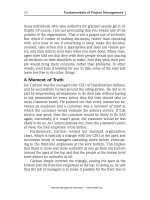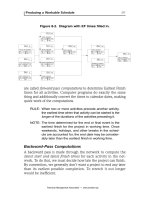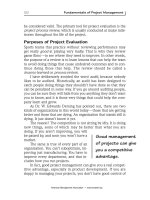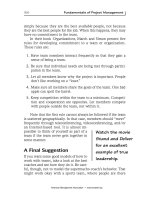IT project management 3rd by THompson chappter 10
Bạn đang xem bản rút gọn của tài liệu. Xem và tải ngay bản đầy đủ của tài liệu tại đây (626.66 KB, 31 trang )
Chapter 10:
Project Communications
Management
Learning Objectives
• Understand the importance of good communication on
projects and describe the major components of a
communications management plan
• Discuss the elements of project communications planning,
including information distribution, performance reporting,
and administrative closure
• Discuss various methods for project information
distribution and the advantages and disadvantages of each
• Understand individual communication needs and how to
determine the number of communications channels needed
for a project
Learning Objectives
• Understand how the main outputs of performance reporting
help stakeholders stay informed about project resources
• Recognize how the main outputs of administrative closure
are used to formally end a project
• List various methods for improving project
communications, such as managing conflicts, running
effective meetings, using e-mail effectively, and using
templates
• Describe how software can enhance project
communications
Importance of Good Communications
• The greatest threat to many projects is a failure
to communicate
• Our culture does not portray IT professionals as
being good communicators
• Research shows that IT professionals must be
able to communicate effectively to succeed in
their positions
• Strong verbal skills are a key factor in career
advancement for IT professionals
Project Communications
Management Processes
• Communications planning: determining the
information and communications needs of the
stakeholders
• Information distribution: making needed
information available in a timely manner
• Performance reporting: collecting and
disseminating performance information
• Administrative closure: generating, gathering, and
disseminating information to formalize phase or
project completion
Communications Planning
• Every project should include some type of
communications management plan, a document
that guides project communications
• Creating a stakeholder analysis for project
communications also aids in communications
planning
Communications Management Plan
Contents
• A description of a collection and filing structure for gathering
and storing various types of information
• A distribution structure describing what information goes to
whom, when, and how
• A format for communicating key project information
• A project schedule for producing the information
• Access methods for obtaining the information
• A method for updating the communications management plans
as the project progresses and develops
• A stakeholder communications analysis
Sample Stakeholder Analysis for Project
Communications
Information Distribution
• Getting the right information to the right
people at the right time and in a useful format
is just as important as developing the
information in the first place
• Important considerations include
– using technology to enhance information
distribution
– formal and informal methods for distributing
information
What Went Wrong?
A well publicized example of misuse of e-mail comes
from the 1998 Justice Department's high profile,
antitrust suit against Microsoft. E-mail emerged as a
star witness in the case. Many executives sent
messages that should never have been put in writing.
The court used e-mail as evidence, even though the
senders of the notes said the information was being
interpreted out of context.
See example of misunderstanding “pedagogical
approach” on p. 358
Table 10-2. Media Choice Table
Figure 10-1. The Impact of the Number of
People on Communications Channels
Performance Reporting
• Performance reporting keeps stakeholders informed
about how resources are being used to achieve
project objectives
– Status reports describe where the project stands at a
specific point in time
– Progress reports describe what the project team has
accomplished during a certain period of time
– Project forecasting predicts future project status and
progress based on past information and trends
– Status review meetings often include performance
reporting
Administrative Closure
• A project or phase of a project requires closure
• Administrative closure produces
– project archives
– formal acceptance
– lessons learned
Suggestions for Improving Project
Communications
•
•
•
•
•
Manage conflicts effectively
Develop better communication skills
Run effective meetings
Use e-mail effectively
Use templates for project communications
Conflict Handling Modes, in Preference
Order
• Confrontation or problem-solving: directly face
a conflict
• Compromise: use a give-and-take approach
• Smoothing: de-emphasize areas of differences
and emphasize areas of agreement
• Forcing: the win-lose approach
• Withdrawal: retreat or withdraw from an actual
or potential disagreement
Conflict Can Be Good
• Conflict often produces important results, such
as new ideas, better alternatives, and motivation
to work harder and more collaboratively
• Groupthink can develop if there are no
conflicting viewpoints
• Research by Karen Jehn suggests that taskrelated conflict often improves team
performance, but emotional conflict often
depresses team performance
Developing Better
Communication Skills
• Companies and formal degree programs for IT
professionals often neglect the importance of
developing speaking, writing, and listening
skills
• As organizations become more global, they
realize they must invest in ways to improve
communication with people from different
countries and cultures
• It takes leadership to improve communication
Running Effective Meetings
• Determine if a meeting can be avoided
• Define the purpose and intended outcome of the
meeting
• Determine who should attend the meeting
• Provide an agenda to participants before the meeting
• Prepare handouts, visual aids, and make logistical
arrangements ahead of time
• Run the meeting professionally
• Build relationships
Using E-Mail Effectively
• Make sure that e-mail is an appropriate medium for what you want
to communicate
• Be sure to send the e-mail to the right people
• Use meaningful subjects
• Limit the content to one main subject, and be as clear and concise
as possible
• Limit the number and size of attachments
• Delete e-mail you don’t need, and don’t open it if you question the
source
• Make sure your virus software is up to date
• Respond to and file e-mails quickly
• Learn how to use important features
Using Templates for Project
Communications
• Many technical people are afraid to ask for help
• Providing examples and templates for project
communications saves time and money
• Organizations can develop their own templates,
use some provided by outside organizations, or
use samples from textbooks
• Recall that research shows that companies that
excel in project management make effective use
of templates
Figure 10-2. Sample Template for a Project
Description
Table 10-3. Sample Template for a
Monthly Progress Report
Table 10-4. Sample Template for a Letter
of Agreement for a Class Project
Table 10-5. Outline for a Final Project
Report









